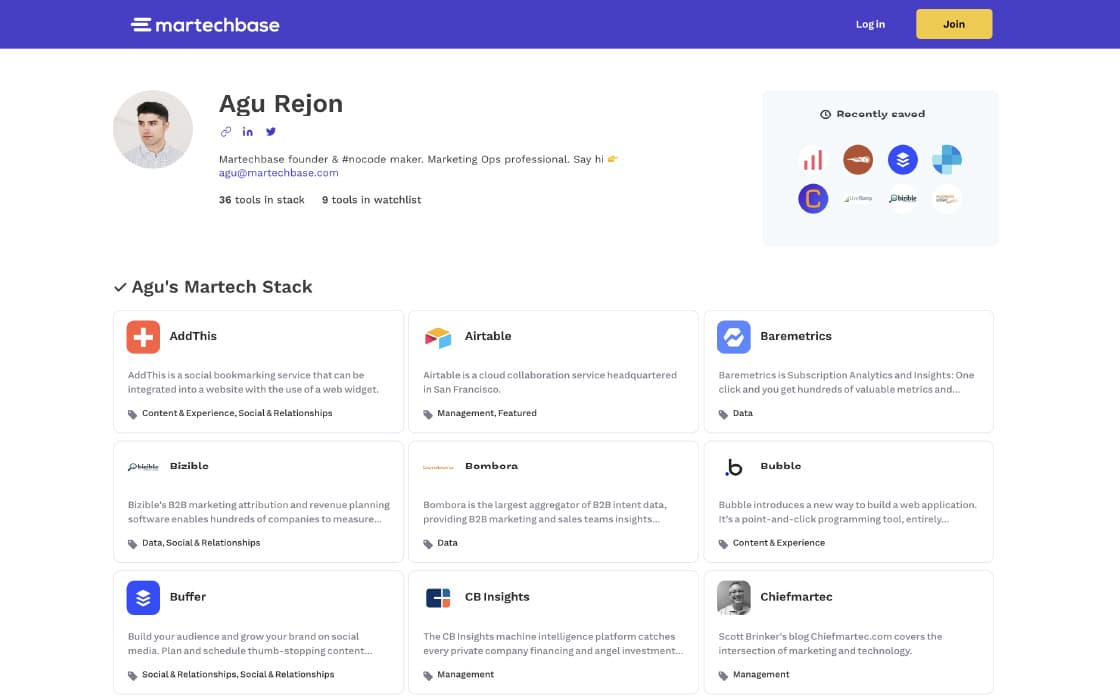Like everyone else who cares about MarTech, we’ve been playing close attention to Scott Brinker’s MarTech 5000 landscape over the last few years.
And like everyone else, we’ve seen the number of companies on that amazing graphic grow so much that it became harder and harder to actually find the companies we were looking for.
Well, we’re incredibly lucky here at Velocity. Because we have someone who patently isn’t like everyone else.
He didn’t just think there might be a better way to navigate Scott’s amazing graphic.
He actually went and built that better way.
It’s called Martechbase.com and we think it’s one of the coolest things you’ll see this year. More importantly, we think it’s one of the most useful things you’ll find this year.
So we grabbed the bass-playing illustrator and creator of Martechbase Agu Rejon—who’s also our head of marketing automation—to talk about what he built and why he built it (you know, before he gets too big to talk to us).
Here’s a lesson in having a great idea—and making it happen.
Congratulations on Martechbase! Let’s start with where you got the idea—it starts with Scott Brinker, right?
That’s right. Like everyone in marketing tech, I check out Scott’s Marketing Tech Landscape graphic every year for an overview of the marketing technology tools that are out there. It’s a big deal point of reference in our industry, and we often use it as a tool in presentations to show clients just how many players there are on the market. Scott’s been doing these graphics since 2011, and in that time, it’s grown from 150 to over 7,000 tools—so it’s a great way of showing clients that there’s a whole sea of vendors to be navigated.
Of course, with 7,000 tools on one graphic, it’s been difficult to use that resource for other purposes. But last year, Scott and his collaborators published the data underneath the graphic for others to use—it has the vendor names and websites, sorted into categories and subcategories. So that data is already useful and searchable. Which is great.
So Scott opened the door to let people find new ways to squeeze value from that data—and also to enrich it, to add stuff like location, annual revenue, number of employees, etc. I wanted to follow Scott’s example in giving something to the martech community for free. That ethos was the starting point for Martechbase.
You aren’t a professional web developer. You don’t write code—so how did you plan on building Martechbase?
I happened to have just started experimenting with NoCode at the time I got the idea. The NoCode movement is really cool.
As the name suggests, NoCode gives people the tools they need to build websites and apps without having any coding skills. You can drag-and-drop elements and create complex workflows and automation rules on the backend to create a highly professional web app. It’s actually the same principle used by most marketing automation systems, like HubSpot or Marketo. So I used Bubble to build Martechbase, and I think the result looks and functions pretty impressively (considering I didn’t write one single line of code).
How did you go about enriching Scott’s data?
First of all, I spoke to Scott to get his permission to use it! I wanted to make sure we were working with him so that his data is the single point of truth for Martechbase. This wasn’t going to be a catch-all list of tools submitted by just anybody. It had to draw on Scott’s list, to be a curated selection by one of the most respected guys in the marketing technology world.
Happily, Scott has been extremely helpful and supportive throughout the process.
Once he gave me the go-ahead, I got in touch with Clearbit. Clearbit is a data-enrichment platform which is typically used by B2B businesses to understand their customers and personalise their sales and marketing journeys.
I approached Clearbit about partnering with Martechbase as I thought the site could really benefit from having the richest data possible. They agreed, which again was a massive help and brought the site’s capabilities to a whole new level.
And now came the really hard part—building the sucka. How long did it take you?
It took me three months to build Martechbase, working late evenings and weekends. Bubble certainly makes things doable and easy—but there was still a lot to be done. Everything from loading the tools to creating a user registration process or writing copy. I wasn’t doing it all alone, and I’d like to thank Doug Kessler and Harendra Kapur at Velocity for supporting the project from the beginning.

So what can people use Martechbase for?
There are four things that you can do with the site right now:
- Search for tools.
Martechbase is a searchable directory of marketing technology tools. So you can search for a kind of tool, and get a shortlist of results.
- See all the information about a company in one place.
On each tool’s page you can see a bunch of information about the company too; the logo, a description, when they were founded, how many employees they have, revenue, location, website, and all their social channels. You can also see ‘related solutions’—this is a list of companies that belong to the same category and subcategory. This is useful if you’re comparing multiple vendors or want to get a sense of what alternatives are out there.
- Find and save useful tools.
As well as acting as a research tool, I wanted Martechbase to help people find and compile the combination of tools they need for a particular job. So users can register as members and add tools to their “stack” or “watchlist”. The stack contains tools they’re currently interested in using, and the watchlist is for tools they want to check out later.
- Learn from other marketers.
Finally, I want the site to be a way for users to market themselves as tech-savvy marketing pros. User profiles are public and for each tool you can see who’s added it to their stack or watchlist. For each user you can see which tools they have added, and so on.

So there’s a community angle to the site that I definitely want to explore further. I think “peeking” into other marketing professionals’ stacks and learning from each other can be hugely beneficial to make sense of the ecosystem.
For instance, you can view the stack that I used to make Martechbase on the About us page or the stack of tools I use for our clients on my own profile.
So were all those late nights and weekends worth it?
Totally! It was a really cool experience building a website, and now it’s up there and getting such a great reaction, it’s obviously very fulfilling.
How has the market reacted to Martechbase so far?
It’s been amazing, and way beyond my expectations.
On launch day, at one point it hit #1 on the Product Hunt chart, and ended up as the #3 Product of the Day.
In its first 3 weeks, it’s had over 19,000 page views (with 9,800 unique visitors) and more than 500 users registered. I’ve shared a bunch of metrics on my Twitter feed—I want this whole project to be as transparent as possible, so I’m making all the analytics public.
And beyond those metrics. it’s been equally gratifying to receive lots of positive feedback from visitors. As strange as it might seem, there’s never been something like this for this niche of marketing technology before, and people are finding it very useful, which is exactly what I was aiming for.
To be honest, I’m really, really excited!
What about the future of Martechbase—what are you going to take it next?
Because it’s always going to be based on Scott’s data, the database will be updated on an annual basis. So if you want to see your tool appear on Martechbase, you’ll need it to feature on Scott’s next Landscape.
In 2020, for the first time, Scott and friends have opened the Landscape up for submissions—so it’s up to vendors to get their tool up there! [Here’s a link to Scott’s submission form.]
In terms of the website itself, I’m going to be looking to add new features very soon. The ultimate goal for me would be for people to be able to use Martechbase to find out what the optimum combination of solutions is for the job they need to do—based on how different solutions integrate with each other.
I also want users to be able to receive custom recommendations based on their current stack. I have some crazy ideas on how to apply AI to power this recommendation engine, but that’s a bit further down the line. So that’s the stuff I’m beginning to work on now.
Finally, this feels like a play that a lot of B2B marketers could be doing: Finding data (or using their own) to deliver new value for their prospects and customers. What advice would you give them?
Don’t get sucked into just one way of solving a problem for your customers. There’s an immense value in experimenting. If you’re curious and invested on an idea, going that extra mile to make it happen can be really fulfilling in the end–even if it means late nights and some headaches along the way.
—
See why we like Agu so much? Go and register on Martechbase. You’ll love it.

Enjoyed this article?
Take part in the discussion








Comments
Allegra Raff Raff Co. Clothing February 13th, 2020
This is so cool! Sorry, guys: I know your content is aimed at B2B marketers, and I’m NOT that (I design clothes for individuals)—but I love it. I always learn something that makes my head pop. Keep it coming.
Doug Kessler February 20th, 2020
Thanks, Allegra! Made our collective day.